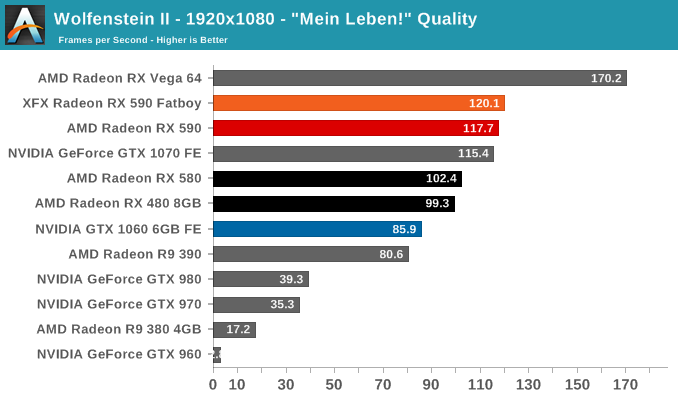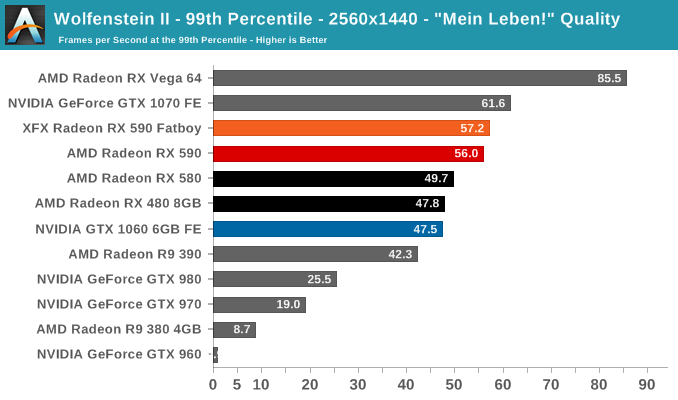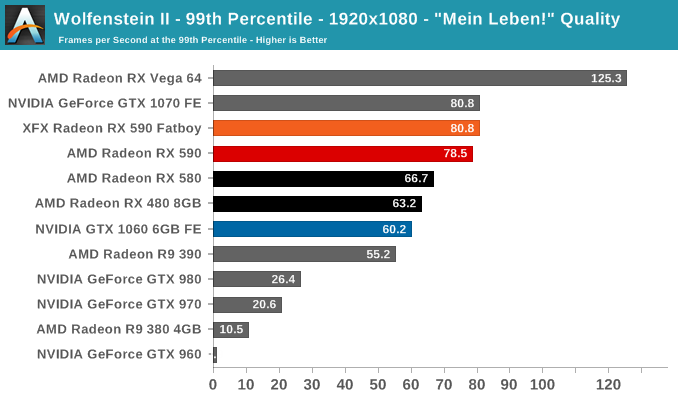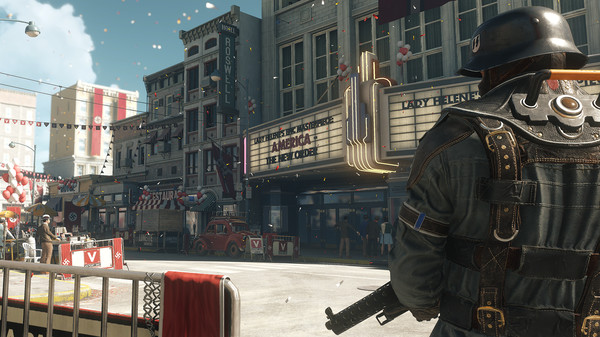The AMD Radeon RX 590 Review, feat. XFX & PowerColor: Polaris Returns (Again)
by Nate Oh on November 15, 2018 9:00 AM ESTWolfenstein II: The New Colossus (Vulkan)
id Software is popularly known for a few games involving shooting stuff until it dies, just with different 'stuff' for each one: Nazis, demons, or other players while scorning the laws of physics. Wolfenstein II is the latest of the first, the sequel of a modern reboot series developed by MachineGames and built on id Tech 6. While the tone is significantly less pulpy nowadays, the game is still a frenetic FPS at heart, succeeding DOOM as a modern Vulkan flagship title and arriving as a pure Vullkan implementation rather than the originally OpenGL DOOM.
Featuring a Nazi-occupied America of 1961, Wolfenstein II is lushly designed yet not oppressively intensive on the hardware, something that goes well with its pace of action that emerge suddenly from a level design flush with alternate historical details.
The highest quality preset, "Mein leben!", was used. Wolfenstein II also features Vega-centric GPU Culling and Rapid Packed Math, as well as Radeon-centric Deferred Rendering; in accordance with the preset, neither GPU Culling nor Deferred Rendering was enabled.


For a game that scales well and enables high framerates with minimal CPU bottleneck, Wolfenstein II has the tradeoff of needing more than 4GB at highest quality settings. This even applies to 1080p! Limited VRAM truly bottlenecks the GPU here, where a card like the enthusiast-grade GTX 980 (4GB) would typically hold its own against the mainstream-grade GTX 1060 6GB.
And so NVIDIA's historical stinginess with video memory hurts them hard here, hammering Maxwell 2 performance as only the GTX 980 Ti and above have more than 4GB of VRAM. The 2GB GTX 960 is reduced to a stuttering fit. Meanwhile, the Hawaii refresh R9 390, whose 8GB memory configuration upgrade was laughed at in 2015, has the last laugh in Wolfenstein II.
Usually, games that devour excessive VRAM have no real reason to do so other than being poor console ports. But the way Wolfenstein II runs on Vulkan has continually impressed me on many levels. It removes so much of the CPU bottleneck and truly enables usage of ultra high refresh rates at any resolution and for a bonafide AA/AAA title. The equally high 99th percentiles are perfect for VR purposes or silky-smooth 'just works' gaming, because regardless Wolfenstein II is a good-looking game. The game and engine also takes a liking to Turing, Vega, and Polaris based cards. If the VRAM consumption is not merely a correlation or coincidence, then that's a perfectly acceptable tradeoff to me.
The spare performance leaves multiple opportunities, too, and as a naive example I wonder if it'd be possible to implement something like DXR accelerated real-time raytracing at 4Kp60.













136 Comments
View All Comments
silverblue - Thursday, November 15, 2018 - link
I was talking about the process; I know the 2000 series has done well.I didn't even know TSMC had a 12nm process, but either it's not very well suited to this application or AMD have just clocked it far too highly, so it's not a successful product in that sense.
frenchy_2001 - Thursday, November 15, 2018 - link
Nvidia's Volta and Turing are fabbed on TSMC 12nm.So, it seems to work well for GPUs, but AMD's architecture is just not competitive in their perfs/watt.
silverblue - Thursday, November 15, 2018 - link
I completely forgot about them.It feels like Polaris is bottlenecked in some way, and increasing clock speeds is just a brute force way of alleviating the issue at the cost of significant power consumption. Perhaps the design is just broken to begin with.
Manch - Friday, November 16, 2018 - link
Memory bandwidth is the bottleneck for Polaris.deksman2 - Friday, November 16, 2018 - link
Power consumption - wise, its the process node from GLOFO that's limiting Polaris mainly from achieving high frequencies and low power consumption.GLOFO nodes are designed for low clocks and mobile parts... 12nmLP is designed for the same, and AMD used it for RX 590.
That's why power consumption explodes on high frequencies.
deksman2 - Friday, November 16, 2018 - link
Polaris is bottlenecked by the GLOFO 12nmLP process that's being used here.It's designed for low clocks and mobile parts.
There was NOTHING posted about AMD using TSCM 12nm node for Polaris refresh. TSMC 12nm was slated for Nvidia.
AMD gets to use TSMC 7nm high performance process node for Zen 2, Vega Instinct and Navi.
eek2121 - Saturday, November 17, 2018 - link
"Limited" is the word you want to use to describe Polaris. "Broken" would imply it doesn't work at all. Polaris was never meant to be a high end architecture. They have just been doing refreshes because they are likely reorganizing their GPU division and coming up with a new architecture to replace GCN. Doing something like that takes time, and AMD has to continue generating revenue. Also, the 590 is not a bad card at all, while I have a 1080ti in my machine, I would definitely consider a Polaris card in any new machine I build (for friends, family, etc.)deksman2 - Friday, November 16, 2018 - link
Incorrect on AMD's architecture not being competitive because AMD is still using GLOFO 12nm LP process for RX 590 which is designed for low clocks and mobile parts.TSMC 16nm and 12nm processes are designed for high performance and efficiency... those nodes are superior to GLOFO (that's why AMD's GPU's end up sucking up A LOT of power at high frequencies - its because the process node from GLOFO cannot take it, and partly because the compute performance on Polaris is a lot bigger than on GTX 1060).
porcupineLTD - Thursday, November 15, 2018 - link
I highly doubt that, any source?deksman2 - Friday, November 16, 2018 - link
Actually 'Cooe', you are incorrect.AMD is using 12nmLP process from GLOFO for RX 590.
You can read about that here:
https://www.pcgamesn.com/amd-rx-590-overclocking-p...
Furthermore, the power consumption on RX 590 should be a dead give-away, because this is exactly the same thing that happened for Ryzen+ too (not to mention the fact we had 0 indications that AMD would refresh Polaris on TSMC 12nm process. NV got access to 12nm TSMC process, not AMD... AMD got access to TSMC's 7nm high perf. process and they have reserved Zen 2, Vega Instinct and Navi for that).
They increased the frequencies on 12nmLP, but as a result they also saw an increase in power consumption.
Polaris is clocked WAY beyond the voltage comfort zone on GLOFO processes (which are designed for low clocks and mobile parts).
If they wanted a refresh, they should have just dropped the frequencies down to 580 levels and call it a more power efficient rebrand.
If AMD moved to TSMC 12nm for RX 590, power consumption on this GPU would actually be lower than on GTX 1060 with those frequencies.